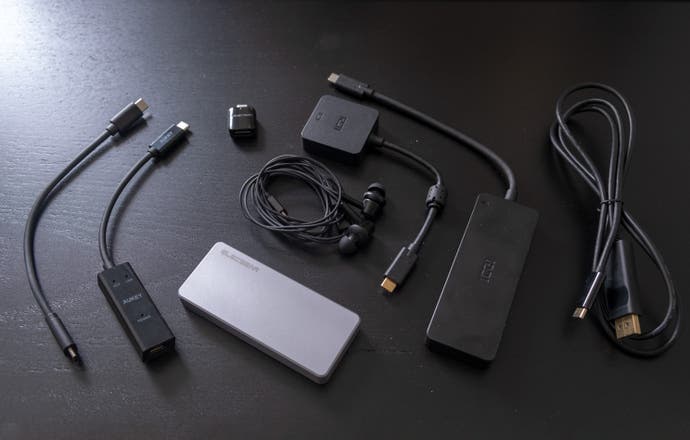PSA: The USB-C port on Nvidia RTX graphics cards isn't just for VR
We connected SSDs, headphones and hubs to see what's possible.
Here's something you might not know: the USB-C VirtualLink port on the back of most Nvidia RTX graphics cards isn't just for connecting VR headsets with a single cable, though that is why Nvidia included it. It also works as a completely standard USB-C port, so in theory you can plug in smartphones, USB hubs, headphones, card readers and even high-speed NVMe SSD storage directly into your GeForce graphics card. This is pretty handy, given that many motherboards only include a single USB-C port and many older models don't include any at all. After learning it was possible, we put an RTX 2080's USB-C port to the test.
In order to check the capabilities of the VirtualLink port, we plugged in as many USB-C devices, hubs and adapters as we could get our hands on. This felt a little odd - when's the last time you plugged a USB mousepad into your graphics card? - but we did get some interesting results. Here's what we tested, what worked and what we learned in the process.

- NVMe SSD enclosure: With an ADATA SX8200 Pro connected to our enclosure (one of the best SSDs for gaming!) we saw sequential speeds of around 750MB/s - far faster than any flash drive, but interestingly not as quick as the 1000MB/s we got when connecting the drive to our motherboard's native USB-C port.
- USB 3.0 hub: This hub added seven USB 3.0 ports to our machine's complement. With this, we were able to plug in an SD card reader, mice, keyboards and USB flash drives.
- USB-C to USB adapter: This simple adapter allowed any full-size USB device to be recognised by our computer, including drives, headsets and mice.
- Android smartphone: We connected our Galaxy S9+ with a USB-C to USB-C cable, allowing us to charge the phone and access its files in Windows. Having the right cable is important here, as a cheap cable only allowed for charging on both motherboard and RTX USB-C ports.
- Headphones: The Razer Hammerhead USB-C headphones we connected worked straight away, showing up as a new audio device in Windows 10.
- Ethernet adapter: With this connected, we recorded the same internet speeds as with our motherboard's internal adapter.
- Monitors: With a DVI-D to USB-C adapter in hand, we were able to connect a DVI-only Crossover 27Q monitor and get its full resolution of 2560 x 1440. We also tried connecting a 4K monitor with a USB-C to DisplayPort adapter, and that worked well - as expected.

So out of the half-dozen devices and adapters we tested, all worked straight away - with the exception of the Android smartphone, which did require a good-quality USB-C cable. We did see reduced speeds on the most bandwidth-heavy test, i.e. the NVMe SSD, but by a relatively small margin that's unlikely to affect usability. If you've already got USB-C devices or adapters for a USB-C phone or laptop, it's worth testing them on your RTX-equipped PC to see if they work there too.
However, it's important to mention that not all devices with USB-C connectors will necessarily work. For example, the USB-C port provided on RTX graphics cards is not a Thunderbolt 3 port, so devices that require the extra bandwidth that Thunderbolt 3 provides (40Gbps versus 10Gbps on USB 3.1) will not work.
Ironically, we weren't able to test the actual stated purpose of the RTX series' USB port: virtual reality. However, users online have reported successfully using an Apple Digital AV Multiport Adapter to connect their VR headsets to an RTX series graphics card using the USB-C input. This isn't really worth doing unless you're on a multi-monitor setup that already takes up all of your graphics card's display outputs, but it's good to know that it's possible. Presumably, future VR headsets will come with USB-C support out of the box, making the VirtualLink functionality a more practical addition.
With the mixed feelings surrounding RTX and DLSS, the addition of a fully capable USB-C port isn't going to suddenly make an RTX graphics card an essential purchase. USB-C VirtualLink isn't even included throughout the series, with many RTX 2060 models dropping the port. Still, if you've already got an RTX card with USB-C, we're hoping this PSA is at least a pleasant surprise.

